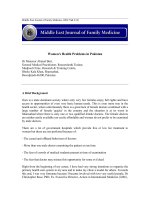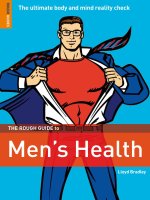Men''''s Health Huge in a Hurry: Get Bigger, Stronger, and Leaner in Record Time with the New Science of Strength Training_2 pptx
Bạn đang xem bản rút gọn của tài liệu. Xem và tải ngay bản đầy đủ của tài liệu tại đây (36.22 MB, 112 trang )
III
HOW TO USE THE PROGRAMS
n Part 3, you'll see exactly how to do the workouts I've been talking about for the previous
seven chapters. I know you can't wait to get to them, so I'll try to keep these instructions
as brief as possible while still giving you the information you need to succeed.
THE BASICS
You know from previous chapters that I'm going to give you a specific number of repetitions to do
for each exercise, rather than a combination of sets and reps. Your goal is to do as many as you
can per set with good form, while lifting as fast as possible. When a repetition is slower than the
first one you did in that set, it becomes the last rep in that set.
As we've discussed, the weight you use will fall into one of these four categories:
Light: a weight you could lift 20 to 22 times
Medium: a weight you could lift 10 to 12 times
Heavy: a weight you could lift 4 to 6 times
Superheavy: a weight you could lift 2 or 3 times
Don't worry about memorizing, since I'll remind you of the range on each workout chart. It'll
look like this:
Load: heavy (4-6 RM)
~
I I ---~-----------------------"
"RM" stands for "repetition maximum,"
USE YOUR WARMUP TO
which means exactly what you think: the
ESTIMATE THE CORRECT LOAD
most reps you can do with a given weight on
Remember the standing cable row I
your first work set, when you're fresh.
described in Chapter 7? Chances are, you've
That's a crucial point, so I'll repeat it:
never done it before, nor have you ever seen
Select your weight based on what you can do
anyone else doing it. You have absolutely no
in your first set. The other sets will take care
way to know how much weight you should
of themselves. You don't need to hold back
use for your first set. Even if I wanted to help
on your first set so you can do the same
you out by suggesting a starting weight, I
number of reps on subsequent sets. It doesn't
couldn't, since I don't know what kind of
matter if you do fewer reps per set as you
cable system you'll be using. Forty pounds
go along.
on one machine might feel like 60 on
But how do you know how much weight to
use on that first set? That is a great question,
another.
That's where your warmup comes in
and contrary to what I just said about being as
handy. Start with what looks like a ridiculously
brief as possible, it requires a detailed answer.
light weight, and try a few reps, focusing on
your balance and form. Go up a plate or two,
and try that. You should know within two or
HOW TO CHOOSE
three reps whether it's the right weight for the
THE RIGHT WEIGHT
category. If it's not, add another plate or two.
On the one hand, my system is simple to use,
As soon as you find a weight that feels right,
since the idea is to do every set of every
rest for a minute, and then use that weight
exercise in each workout with the same
for your first work set. If you selected
weight. But what if you don't use the correct
correctly, you should be able to use that
weight on the first set? And if you've never
weight for all your sets.
done that particular exercise in that particular
rep range, how do you even guess how much
to start out with?
The answer is "trial and error." The
ADJUST THE WEIGHT UP OR
DOWN FOR YOUR SECOND SET
following strategies should help you get it right
SO you've selected a weight that you think
sooner rather than later.
qualifies as "heavy"-one you can lift four
THEBRAWN
to six times on your first set. But you shoot
MANAGING YOUR REPETITIONS
past your sixth rep and get seven without
Let's say you've gotten it exactly right on
slowing down or changing your form, and
your first set. The workout calls for 25 total
you know you could keep going for another
reps with a "heavy" load, and you get four,
rep or two, or maybe even three. Here's what
five, or six reps with the weight you've
you do:
selected. Now what?
» Stop at seven reps. I don't want you to stop
at six if you haven't slowed down, since that
puts the wrong idea into your head. You'll
start focusing on reps instead of rep speed.
But it's easy enough to quit at seven.
» For your second set, add 2 percent or
5 pounds, whichever is more, and take the
designated amount of rest. If you still blow
past six reps, stop after seven, and add
another 2 percent or 5 pounds.
» If that doesn't work, and you get past six
again, do the same adjustment for your final
set. Stop when you hit your 25th total rep,
and plan to use more weight the next time
you do that workout.
If the weight is too heavy, and you can't
get four reps on your first set without slowing
down, make the adjustment in reverse: sub-
Different lifters recover at different
speeds, so nobody can predict what will
happen on subsequent sets. If your nervous
system is efficient at recruiting the largest
motor units, your second set will probably be
around four reps. If it isn't efficient- it needs a
set or two before you can tap into your largest
motor units- you might be able to get seven
reps on your second set before the speed slows
down. That's fine. The key is to get the first
set right.
Which brings me to another important
point: After the first set, you might not get
four reps with a heavy load before your speed
slows down. That's fine, too.
Let's look at two potential outcomes,
tract 2 percent or 5 pounds, whichever is more.
based on the lifter's experience. A veteran
If that's still too much, subtract again, and
musclehead might reach 25 reps this way:
continue until you get it right.
Set 1: 5 reps
On some exercises- particularly, squats
and deadlifts- there's a chance you'll miss by
Set 2: 5 reps
a lot more than 2 percent or 5 pounds. If it's
Set 3: 4 reps
clear you need to add or subtract more than
Set 4: 4 reps
what I recommend, use your own judgment. I
Set 5: 4 reps
just want you to avoid having to make reverse
adjustments on subsequent sets, overshooting
in one direction and then undershooting in
the other.
92
Set 6 : 3 reps
Conversely, a novice lifter's workout chart
might look like this:
HOWTOUSETH EPROGRAMS
Set 1: 6 reps
Each phase is followed by a week of
Set 2: 7 reps
workouts (usually designated as "unloading")
Set 3: 6 reps
designed to help you with recovery and boost
your benefits. You won't work out at all the
Set 4: 6 reps
The experienced lifter has more ability to
16 th and final week of each phase.
Nothing in this book will work if you don't
recruit his largest motor units. That's why he
push yourself to improve your performance
might be working with three times as much
from one week to the next. Different programs
weight as the beginner on any given exercise.
emphasize different types of progression, such
Those big motor units can't recover as fast as
as higher volume for hypertrophy, heavier
smaller motor units, which is why the vet's
weights for strength, and shorter rest periods
first set with a heavy or superheavy weight
for fat loss. But the most important progres-
will generally be his best set on that exercise.
sion is the amount of weight on the bar. As
Meanwhile, the entry-level lifter is using
soon as you can exceed the designated number
smaller motor units. His inability to tap into
of repetitions you perform on your first set of
the biggest ones limits the amount of weight he
each exercise, add 2 percent or 5 pounds,
can lift, but the motor units he can recruit
whichever is more. You should be able to do
recover faster. That's why his performance
this on almost every exercise from one week to
tends to improve on his second set, and why it
the next.
doesn't fall very far on subsequent sets.
CIRCUITS AND SUPERSETS
PROGRESSION
In a perfect world, I'd design virtually all of
The programs in Huge in a Hurry have similar
my workouts as circuits-doing a set of every
structures: Most take 16 weeks. The programs
exercise in the routine before repeating an
include three 4-week phases. Each phase has
exercise. You'd end up with about 3 minutes
three workouts- A, B, and C. Ideally, you'll
to recover from one set of an exercise to the
do three workouts a week, with at least 1 day
next set of that exercise. In my experience,
off in between (Monday, Wednesday, and
that's the most effective and time-efficient
Friday, for example), and complete the phase
way to train.
in 4 weeks. If you can't do three workouts
The world, alas, is imperfect. If you work
every week, make sure you do workouts A, B,
out in a commercial gym, you can't take up
and C four times each, in that order, before
three stations for the duration of a workout.
you move on.
Even if you work out at home, you might not
93
THEBRAWN
have enough equipment to set up for three
load, a weight you could lift four to six times
different exercises at the same time.
while fresh. You know you can do a lot of dips
So, reluctantly, I prescribe straight sets for
with your body weight, so you wear a dipping
most of the workouts in this book. If, however,
belt with a lO-pound weight attached. The
you have the luxury of performing any of the
problem is that you're not yet very good at
workouts as a circuit, I recommend it. Or, at
doing chinups with your body weight. You do
least, try it for a workout to see if you like it.
just three or four chinups per set, compared
Or alternate circuits and straight sets each time
with five or six dips. You hit your target reps
you repeat a workout.
on dips with four chinups left to perform.
If a workout includes the chinup, dip, and
The solution is simple enough: Just
deadlift, with 60 seconds of rest between sets,
continue with the chinups as straight sets until
a circuit would look like this:
you finish all your reps, resting for the desig-
» Chinups
nated time after each set. In most cases, it
» Rest 60 seconds
takes only one set to make up the difference.
» Dips
» Rest 60 seconds
ORPHAN REPS
» Deadlifts
Here's a question that will come up the first
» Rest 60 seconds
time you do these workouts: What do you do
with leftover reps? If the target is 25 reps, and
» Repeat the circuit
Another option, which is more realistic for
many lifters, is to alternate between the two
upper-body exercises, and then finish the
workout with straight sets of the lower-body
after five sets you've completed 24, what
happens to the leftover rep? You're going to
hate my answer.
Take the specified amount of rest, and then
do the final repetition as its own set.
exercise. As with the circuits I just described,
See, I knew you'd hate the answer.
you'd take the designated amount of rest after
But you don't have to like the solution to
each set of each exercise.
One potential problem: You do more reps
appreciate the logic behind it. If you don't do
the final rep, your workout doesn't have the
per set with one exercise, which means you
requisite volume. If you do more reps in that
reach the target reps with that exercise before
final set, the volume exceeds the parameters,
you finish the others.
which can affect your recovery and your
Let's say your workout starts with chinups
and dips, and you decide you're going to superset those two exercises. It calls for a "heavy"
94
performance in future workouts.
The same answer applies to two corollary
questions:
HOWTOUSETHEPROGRAMS
However, in my experience, too many
» What happens if I hit the target reps when
I'm in the middle of a set, and I know I can
do two or three more?
inexperienced or moderately experienced
lifters trust instincts they don't yet have. They
» If I get to within one rep of the target and my
speed starts to slow down , is it okay to grind
out that last repetition , even though it's
noticeably slower than the others?
start improvising with workouts designed by
people like me before they've given them a
chance to work.
So, I'm not saying the programs won't
In the first scenario, yes, I really do want
work unless you do them exactly as written.
you to stop the set even though you're leaving
And I'm certainly not the kind of control freak
one or more reps in the tank. In the second, no,
who blows a head gasket if anyone questions
I don't want you to grind out that last rep.
my philosophy of program design. As former
Those are the official answers. But, to be
nightclub bouncers go, I'm surprisingly
honest, I know you're going to follow your own
instincts. That's what experienced lifters are
easygoIng.
All I ask is this: Try it my way first , before
supposed to do. You learn by experimenting
you start improvising. You'll at least under-
and you come to trust your own judgment.
stand how I meant for it to work.
SAMPLE TRAINING LOG
PROGRAM/STAGE:
WORKOUT:
SET 1
SET 2
SET 3
SET 4
SET 5
SET 6
SET 7
SET 8
UPPER-BODY PULL
UPPER-BODY PUSH
SQUAT OR DEADLIFT
VARIATION
ACCESSORY EXERCISE
NOTES:
95
THEBRAWN
PUTTING TOGETHER
A LONG-TERM PROGRAM
I've trained just about every type of athlete,
from fighters to figure competitors, and just
about every type of nonathlete, from young to
old and thin to thick. What I don't know is
how to classify you personally. I can guess that
you're a male, under 40, who bought this book
to learn how to put on a lot of muscle mass in
as little time as possible. (Who else would buy
a book called Men 's Health Huge in a Hurry?)
But I can't possibly make assumptions
You're free to use these workouts in any
order you want, with just two rules:
» Everyone should do the 3-week prep
workouts in Get Ready. It doesn't matter
whether you 've been training for 20 minutes
or 20 years. You will not get the results you
want from the other programs if you skip this
step. You need this step to train your body to
do the workouts that follow.
» Always do the basic workouts (Get Big or Get
Strong) before tackling the advanced programs
(Get Even Bigger or Get Even Stronger).
Other than that, you're free to start off
about your genetics, your experience, your
with Get Big, Get Strong, or Get Lean. I
skill as a lifter, your comfort level with
think most readers will get the best results by
unfamiliar lifts and techniques, or any of the
doing the hypertrophy workouts before the
dozens of variables that determine the best
strength programs, but the most advanced
way for you to use my workouts.
lifters can certainly go straight from Get
If you've read the Contents, you know that
the chapter following this one is called Get
Ready to Get Strong.
The fat-loss programs in Get Lean employ
Ready, and you can probably guess that it
Olympic lifts, which certainly involve a learn-
includes an introductory workout, designed to
ing curve. That's why I think most readers will
prepare you for the ones that follow.
be better off doing the hypertrophy or strength
Likewise, I'm sure you've figured out that
workouts before tackling fat loss. But an
the chapter called Get Big focuses on muscle
experienced lifter could start there, and then
hypertrophy, and that the subsequent chapter,
move on to Get Big or Get Strong.
Get Even Bigger, includes an advanced
hypertrophy program. (Actually, it has two
Here are some suggested paths for lifters
at different levels.
advanced programs; you' ll learn why when
you get there.)
Then there's Get Strong (a strength
LESS THAN 2 YEARS
OF SOLID TRAINING EXPERIENCE
1. Get Ready
program) and Get Even Stronger (an advanced
strength program) . I wrap up with Get Lean,
2. Get Big
and I won't insult your intelligence by explaining what that title means.
98
3. Get Strong
4. Get Lean
HOWTOUSETHEPROGRAMS
s. Get Even Bigger (optional)
3. Get Even Stronger
6. Get Even Stronger (optional)
4. Get Lean
2TOSYEARS
OF SOLID TRAINING EXPERIENCE
S. Get Big
6. Get Even Bigger (optional)
1. Get Ready
2. Get Big
3. Get Even Bigger (optional)
Again, these aren't the only ways to do
these programs, and I don't want to talk
anyone out of trying anything, as long as you
4. Get Strong
use common sense and follow the two invio-
s. Get Even Stronger (optional)
lable rules: Do Get Ready first, and do the
6. Get Lean
basic programs before the advanced ones in
the same category. If you need to lose a lot of
MORE THAN 5 YEARS
OF SOLID TRAINING EXPERIENCE
1. Get Ready
2. Get Strong
fat, it's best to start with Get Lean. The leaner
you are, the less likely it is that you'll add fat
when you put on muscle.
Now, finally, it's time to lift.
97
GET READY
re you ready for a little cognitive dissonance? Here it comes: Throughout this
book, I've been pushing the idea of lifting with maximal speed with enough
volume and weight to get the results you want, while maintaining perfect form.
That's too much to master all at once, which is why I want you to start with
this break-in program. You'll do three total-body workouts a week for 3 weeks,
with the goal of getting used to my workout parameters.
It's that whole "walk before you run" thing.
And yes, I want everyone to do this program. It doesn't matter whether you're a beginner,
intermediate, or advanced lifter. In fact, I don't even want you to think in those terms right now.
Even if you've been training for 20 years, a lot of this will be new to you.
Your goal in these first 3 weeks is to focus on the speed of your lifts in conjunction with
your form.
All of the parameters will remain constant except for the load you use for each exercise. The
reason the load won't remain constant is because for the first few weeks, you'll probably miscalculate the weight that corresponds with the prescribed rep range. Each week you'll probably be
able to add at least 5 pounds since your nervous system and muscles will quickly adapt.
This 3-week phase serves two essential purposes. First, it teaches you to focus on speed and
total reps per exercise instead of a target number of sets and reps. So instead of doing five sets of
5, you'll perform as many sets as it takes to get to 25 total reps and stop each set when the last rep
is noticeably slower than the first rep. Second, it prepares you for the core programs that are
outlined in the following chapters.
CABLE STANDING MID-PULLEY ROW
TOTAL REPS: 25 REST (SECONDS): 45
(PAGE 213)
---
UNDERHAND-GRIP LAT PULLDOWN
(PAGE 211)
TOTAL REPS: 35 REST (SECONDS): 60
---
CABLE STANDING LOW-PULLEY ROW
WITH ROPE ATTACHMENT (PAGE 216)
TOTAL REPS: 50 REST (SECONDS): 90
'Start with your weaker side first. then immediately do the same number of reps with your stronger limb. Rest after working both sides.
102
--==':':..ll-
I
•
$
'
-
DIP OR DUMBBELL DECLINE BENCH
PRESS WITH NEUTRAL GRIP (PAGES 223 AND 227)
[ TOTAL REPS: 25 REST (SECONDS): 45
--
--
--
DUMBBELL SPLIT SQUAT*
(PAGE 247 )
TOTAL REPS: 25 REST BETWEEN SETS (SECONDS): 45
--- -
- ----
~------------------------------~
,...----------------
-- -- - - -
DUMBBELL STANDING
SHOULDER PRESS (PAGE 234)
DEADLIFT
TOTAL REPS: 35 REST (SECONDS): 60
TOTAL REPS: 35 REST (SECONDS): 60
PUSHUP
SQUAT (PAGE 241)
(PAGE 231)
TOTAL REPS: 50 REST (SECONDS): 90
(PAGE 254)
TOTAL REPS: 50 REST (SECONDS): 90
103
GET BIG
icture two Olympic athletes. The first is a weightlifter. As you expect, he has
huge thighs, and if you watch him perform snatches and cleans in competition,
you understand why. Those lifts force him to drop into a full squat, ass to calves,
with hundreds of pounds held overhead or on the front of his shoulders. Then he
has to stand up from that position. You imagine his thigh muscles grow just
thinking about doing something so obviously extreme and difficult.
The second is a cyclist. He also has large, well-developed thigh muscles- not nearly as big as
the weightlifter's, but still showing obvious signs of training-induced muscle growth. And yet, the
demands of his sport don't in any way resemble Olympic weightlifting. He probably does some
strength training, but it's unlikely to involve all-out, max-effort lifts. Almost all his training is on
the bike, with a focus on endurance. So how did his thighs get so big?
Short answer: Because all of your muscle fibers, from the smallest to the largest, have the
potential to grow.
But if we leave the comparison where it stands, we negate everything I've written so far about
the importance of tapping into your biggest and most powerful motor units. Right?
Not really. Let's consider two important qualifiers that I haven't yet mentioned:
» The cyclist only has this kind of development in one muscle group: his quadriceps. He might also
have reasonably well-developed calves, but if you just looked at him from the waist up, you'd
never guess that he's an elite athlete. On the other hand, if the weightlifter walked into a room,
he'd look like a guy who lifts weights. Even if you didn't know why he lifted, you'd guess in an
instant that he's a serious athlete of some sort.
» The weightlifter achieved a high level of overall muscularity in a fraction of the time the cyclist
spent building his thighs-perhaps 10 hours a week of lifting, versus several times that riding .
My goal when I designed this 16-week muscle-building program was to include all five of the
key consideration8 for muscle growth- three that I've covered in detail elsewhere in this book,
and the two I just noted:
» Recruit all your motor units.
» Induce enough fatigue for them to grow.
» Give them plenty of food (you'll find the details in Chapter 23).
» Hit all the major muscles with a variety of movement patterns.
» 00 all this in the most time-efficient way possible.
Results? I think you can expect to add 10 pounds of muscle in this 16-week program. Some of
you who haven't been training will do much better and add a pound each week, while others will
remain in single-digit muscle growth. But I'm confident that everyone will notice an impressive
difference after 4 months.
CHINUP
BARBELL DECLINE CLOSEGRIP BENCH PRESS (PAG:226) J
E =
(PAGE 207)
TOTAL REPS: 25 REST BETWEEN
SETS (SECONDS): 60
TOTAL REPS: 25 REST BETWEEN
SETS (SECONDS): 60
CABLE SEATED ONE-ARM
ROW WITH NEUTRAL GRIP*
DUMBBELL STANDING
ONE-ARM SHOULDER PRESS*
------'
(PAGE 217)
(PAGE 235)
TOTAL REPS: 40 REST (SECONDS): 75
TOTAL REPS: 40 REST (SECONDS): 75
-----I
HIGH PULL
(PAGE 263)
TOTAL REPS: 25 REST (SECONDS): 60
DUMBBELL INCLINE
BENCH PRESS (PAGE 227)
TOTAL REPS: 25 REST (SECONDS): 60
'Start with your weaker side first. then immediately do the some number of reps with your stronger limb. Rest after working both sides.
106
DEADUFT
STANDING SINGLE-LEG
CALF RAISE* (PAGE 280)
(PAGE 254)
I
(SECO ~
TOTAL REPS: 25 REST BETWEEN SETS (SECONDS): 60
TOTAL REPS: 25 REST BETWEEN SETS
BULGARIAN SPUT SQUAT
DUMBBELL STANDING ONE-ARM
TRICEPS EXTENSION* (PAGE 285)
(PAGE 248)
TOTAL REPS: 40 REST (SECONDS): 75
IFRONT SQUAT (PAGE 242)
TOTAL REPS: 25 REST (SECONDS): 60
--------'
TOTAL REPS: 40 REST (SECONDS): 60 _ _ _ _ _--'
HAMMER CURL
(PAGE 284)
TOTAL REPS: 25 REST (SECONDS): 45
107
CABLE STANDING MID-PULLEY FACE PULL (PAGE 214)
TOTAL REPS: 50 REST (SECONDS): 75
- - - - - - ----
LAT PULLDOWN
(PAGE 210)
TOTAL REPS: 30 REST (SECONDS): 60
CABLE SEATED FACE PULL
(PAGE 217)
TOTAL REPS: 30 REST (SECONDS): 60
108
CABLE STANDING CHEST PRESS
DUMBBELL ROMANIAN DEADLIFT
(PAGE 229 )
TOTAL REPS: 50 REST (SECONDS): 75
I (PAGE 256)
l!OTAL REPS: 50 REST (SECONDS): 75
__
---------~
DUMBBELL STANDING
SHOULDER PRESS (PAGE 234)
SIDE LUNGE
TOTAL REPS: 30 REST (SECONDS): 60
TOTAL REPS: 30* REST (SECONDS): 60
(PAGE 249)
'With each leg
PUSHUP WITH HANDS
ON SWISS BALL (PAGE 232)
CABLE SQUAT (PAGE 246)
TOTAL REPS: 30 REST (SECONDS): 60
TOTAL REPS: 30 REST (SECONDS): 60
109
PULLUP
DIP
(PAGE 207)
TOTAL REPS: 15 REST (SECONDS): 4~
(PAGE 223)
-
o'
e.
e
•
TOTAL REPS: 15 REST (SECONDS): 45
-~
L
CABLE STANDING ONE-ARM
MID-PULLEY ROW, PALM UP*
(PAGE 214)
-- - - -
I
TOTAL REPS: 40 REST (SECO~
•
DUMBBELL ONE-ARM BENCH
PRESS* (PAGE 228)
TOTAL REPS: 40 REST (SECONDS): 75
-----1
CABLE STANDING
MID-PULLEY ROW WITH
NEUTRAL GRIP (PAGE 213)
DUMBBELL STANDING
SHOULDER PRESS
TOTAL REPS: 40 REST (SECONDS): 75
TOTAL REPS: 40 REST (SECONDS): 75
(PAGE 234)
'Start with your weaker side first. then immediately do the same number of reps with your stranger limb. Rest after working bath sides.
110
Ir
STANDING SINGLE-LEG
CALF RAISE (PAGE 280)
HACK SQUAT (PAGE 245)
TOTAL REPS: 15 REST (SECONDS): 45
----------'
TOTAL REPS: 15 REST (SECONDS): 30
l
I
DUMBBELL SINGLE-LEG
DEADLlFT* (PAGE 257)
DUMBBELL DECLINE ONE-ARM
TRICEPS EXTENSION* (PAGE 287)
TOTAL REPS: 40 REST (SECONDS): 75
TOTAL REPS: 40 REST (SECONDS): 60
_
SQUAT (PAGE 241)
BARBELL CURL (PAGE 283)
TOTAL REPS: 40 REST (SECONDS): 75
TOTAL REPS: 40 REST (SECONDS): 60
--
----'------
111
CABLE SEATED FACE PULL
(PAGE 217)
TOTAL REPS: 50 REST (SECONDS): 70
WIDE-GRIP LAT PULLDOWN
--------
(PAGE 211)
TOTAL REPS: 30 REST (SECONDS): 55
----
CABLE STANDING MID-PULLEY FACE PULL
TOTAL REPS: 50 REST (SECONDS): 70
112
(PAGE 214)
I
I
DUMBBELL STANDING
SHOULDER PRESS (PAGE 234)
QUARTER SQUAT
~TAL
TOTAL REPS: 50 REST (SECONDS): 70
_
L--
J
PUSHUP WITH HANDS
ON SWISS BALL (PAGE 232)
TOTAL REPS: 30 REST (SECONDS): 55
(PAGE 241)
REPS: 50 REST (SECONDS): 70
SIDE LUNGE
(PAGE 249)
TOTAL REPS: 30* REST (SECONDS): 55
'With each leg
l
CABLE STANDING CHEST PRESS
TOTAL REPS: 50 REST (SECONDS): 70
~
--
(PAGE 229)
--
DUMBBELL ROMANIAN DEADLIFT (PAGE 256)
TOTAL REPS: 50 REST (SECONDS): 70
113
POWER CLEAN
(PAGE 265)
DUMBBELL INCLINE
BENCH PRESS (PAGE 227)
TOTAL REPS: 15 REST (SECONDS): 45
TOTAL REPS: 15 REST (SECONDS): 45
CABLE STANDING ONE-ARM
MID-PULLEY ROW, PALM UP*
CABLE STANDING
ONE-ARM CHEST PRESS*
(PAGE 214)
(PAGE 230)
TOTAL REPS: 40 REST (SECONDS): 75
TOTAL REPS: 40 REST (SECONDS): 75
NEUTRAL-GRIP PULLUP
-
o
0
I
e ,-
=
-
(PAGE 209)
DIP
TOTAL REPS: 25 REST ISE:COIND
TOTAL REPS: 25 REST (SECONDS): 60
(PAGE 223)
'Start with your weaker side first, then immediately do the same number of reps with your stranger limb, Rest after working bath sides,
114









